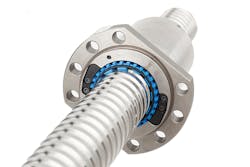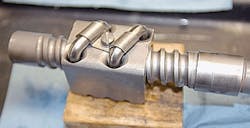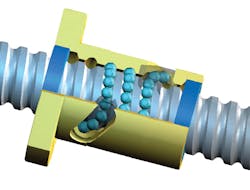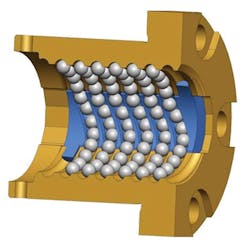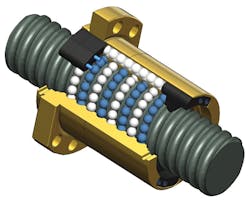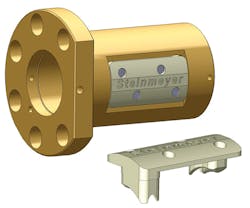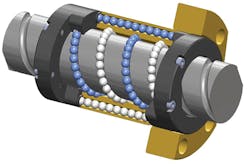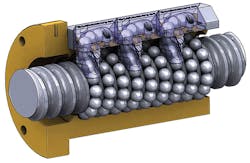Ball-Screw Design: The Advantages of Internal Ball Returns
This file type includes high-resolution graphics and schematics when applicable.
Lead screws are one of the most common linear-motion devices, thanks to their low cost and reliability. And recent advances in modern machining can make them extremely precise with lead errors below 1 micron. That’s why they can be found in linear drives for machine tools, aerospace controls, precision stages, and a host of industrial devices.
However, lead screws are fundamentally limited. The sliding between the threads of the shaft and nut generates high frictional forces. As a result, lead screws struggle to reach even 50% in efficiency. Of course, the friction also generates heat, which limits the rotational speed to a few hundred rpm. Furthermore, there is backlash because of play between the threads.
For some applications, such as actuation and coarse, low-load positioning, efficiency is not that important and backlash can be tolerated. But for many others, particularly high-load CNC machining, these limitations are critical. Low efficiency requires much larger drive motors, and backlash interferes with precision servo control. Any attempt to eliminate backlash by pre-loading causes even higher friction and lowers efficiency to below 30%.
Placing ball bearings inside the nut assembly and pre-loading them to maintain contact overcomes these problems; efficiency soars to over 90% and backlash is eliminated. Adding those bearings gave rise to the ball screw (see "A Short History on Ball Screws").
Problems of Tube Returns
One challenge in ball-screw design is ball recirculation. Historically, the most common designs used tubes that jutted outside the nut and provided a return path back to the beginning of the ball track inside the nut. But tube returns force each ball to change direction by 90 deg. at the end of each tube. This extreme change in motion causes higher frictional losses and also increases the risk of balls jamming. It also increases the variation in frictional torque.
Tube returns also suffer a loss of lubricant. The port where the tube enters or leaves the nut body is difficult to seal. As a result, tube-return ball screws tend to leak, a costly and messy maintenance problem.
Tubes are also generally incompatible with rotating nut configurations. The reason is that the tubes create asymmetric radial forces as the nut rotates. Radial forces cause vibrations and instability at high speeds.
Over the past decade, CNC machine tools have been a leading user of ball screws. This application requires pre-loading, which presents challenges for tube returns. One key measure of ball-screw performance is the speed rating (DN), expressed as the shaft diameter (mm) times the maximum rotation rate (rpm). Tube-return ball screws are limited to a DN of around 70,000. Not only that, the pins required to deflect the balls in tube returns are subject to failure.
Internal Returns
At Steinmeyer, engineers have taken a different approach, exclusively favoring internal returns over tubes. Their overriding design principle with returns is to follow the natural trajectory of the ball. So all Steinmeyer returns are based on tangential deflection. This minimizes the required deflection forces, resulting in higher efficiencies and reliability. And with no tube connection, no lubricant escapes the nut.
One historical argument against internal returns is that they are incompatible with rapid design and high-volume manufacturing. After all, the reasoning went, external returns require only a hole in the nut and a bent tube. To make internal returns easier to manufacture, Steinmeyer fabricates deflectors in-house by milling (steel or brass) or other additive methods (plastic). Combining these fabrication techniques with modern CAD tools, the company economically designs and manufactures a variety of complex shapes in high volume.
Steinmeyer’s internal returns fall into six categories: track-to-track, liner, and four variations on through-the-nut—Z-UltraSpeed, Deflector, endcap, and heavy duty.
Track-to-track: The track-to-track return is the original Steinmeyer design and still the most widely used. It is available on the widest range of shaft diameters and nut types. It uses ball deflectors to lift balls across the shaft’s outer diameter and guide them directly into the next (or previous) track. Each deflector serves one turn, which corresponds to one ball circuit.
Deflectors are made of metal or plastic and sealed into bore holes in the shaft. It’s impossible for lubricant to leak out. The deflectors are arranged symmetrically to balance radial forces and are flush with the nut’s outer surface.
This design is compact and has the smallest nut diameters of all ball returns. It is also the preferred choice for small balls and lead/diameter ratios less than 0.5. It can have a DN as high as 120,000.
Liner: The liner return is a variation on track-to-track deflectors. The liner essentially consists of several deflectors arranged and manufactured as a single component. It is placed entirely inside the nut, eliminating the need for bore holes.
It was developed for the aerospace industry where coarse-positioning ball screws must reliably control aerodynamic surfaces, cargo doors, and cockpit-seat adjustments. None of these applications require pre-loading, so tube returns dominate older, legacy designs. But liner returns have many advantages especially suited to aerospace applications:
* They generate higher load capacities per unit nut length, so shorter and lighter nuts can be used.
* They are easier to assemble compared to individual ball deflectors because there are no holes in the nut and fewer parts.
* Unlike tube returns, liners require no additional hardware for the return, and lubricant leaks are impossible.
Liner returns provide both safety and reliability. Unlike tube returns, balls cannot leave the nut if a deflector or the liner fails.
Through-the-nut (“UltraSpeed”): Through-the-nut returns were originally developed for high-speed operation of high-lead ball screws. The UltraSpeed, for example, uses deflectors at each end of the nut. Balls get lifted off the shaft, guided through a bore inside the nut body, and set back onto the shaft. One pair of deflectors serves one circuit, which includes several turns.
This nut design is normally used for lead/diameter ratios greater than 0.5 and dual start threads (that is, two separate thread paths on the shaft) It can reach a DN of 160,000. This speed corresponds to more than 90 m/min (1.5 m/s). Dual-start threads are typically used for vertical-axis applications because two deflectors per start provide redundancy against failure.
Through-the-nut (“Z-Deflector”): The Z-Deflector is another version of the through-the-nut return. It was designed for shafts with solid bearing shoulders on both ends of the threaded shaft. On these shafts it is impossible to thread the nut on from a sleeve with the balls in place. Thus, technicians install the nut on the shaft without balls, then insert balls through the opening in the nut body, and finally affix the Z-Deflector.
Through-the-nut (endcap): The endcap return is similar to the UltraSpeed return, except that caps at both ends of the nut serve as ball deflectors. This design is normally used for lead/diameter ratios greater than 0.5, and nuts with two or more start threads for high load capacity in a short nut. The endcap is usually made of plastic, which lowers weight and keeps the ball screw 50% quieter when operating. Furthermore, the extra length of the endcaps accommodates combination wipers, which include both a felt ring and plastic fingers.
Endcap returns are available on shaft diameters from 5 to 20 mm and leads from 2 to 30 mm. They can handle up to five ball circuits, which pushes the dynamic load capacity to over 30 kN.
This return withstands accelerations over 1 g. As a result, one of its main applications is in devices requiring speeds greater than 2 m/s.
Through-the-nut (UltraThrust): To increase the load capacity of ball screws, Steinmeyer engineers placed oversized balls (15 to 19 mm) in their standard track-to-track return. (Previously, the largest balls were about 11-mm in diameter.)The resulting ball screws had dynamic capacities up to about 800 kN. More recently, the firm developed a ball return that consists of several through-the-nut returns along the length of the nut. Plastic deflectors move balls tangentially out of the nut raceway.
The return is available in shaft diameters from 32 to 160 mm and leads of 10 to 30 mm. For the smallest diameters, they have a dynamic capacity of over 100 kN (about four times as high as a standard 32-mm screw). For the largest diameter, dynamic capacity approaches 1,400 kN.
The main purpose of the UltraThrust return is to let ball screws replace hydraulics in a greater number of applications. Electromechanical drives offer improved efficiency and lower environmental impact, which is leading to an increasing demand for high-thrust screws.
Steinmeyer is constantly working on further development of deflectors, both in terms of improving the geometry as well as minimizing size and cost. We expect to achieve these advances through better materials and manufacturing processes.
Bruce Gretz is National Key Accounts Manager for Steinmeyer Inc.


